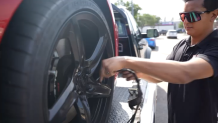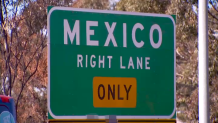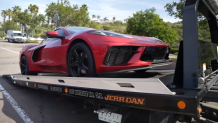One of the many nice things about living in a border city is being able to drive to Mexico for a quick visit. But what if your car breaks down while you’re there?
It may be cheaper to repair it in Mexico, but if you don’t know a trusted mechanic there, you may prefer to get it back to San Diego.
One option is having your car towed back across the border, and several cross-border towing companies can do that. It’s easier than you think, although you’ll need to have some specific documents on hand.

Get San Diego local news, weather forecasts, sports and lifestyle stories to your inbox. Sign up for NBC San Diego newsletters.
Steven Estrada from RJ Towing says he knows everything about towing cars across the border, no matter which way. He’s been in the family business for 12 years. He says he started helping his dad run the company when he was 18 years old.
Estrada said he has towed hundreds of cars between Tijuana and San Diego. He said he’s helped people who lost their keys, whose car broke down or who were in an accident and couldn’t drive back home.
He said the cost is about $400 to $450 if picking up in Tijuana, and if you’re stuck in Rosarito or Ensenada that can cost you around $600. He added that the price is fixed regardless of how long it takes to cross to San Diego.
Local
“We can’t control that, but it’s already included in that price, so the price doesn’t change. If we’re at the border for one hour or five hours,” he said it remains the same.
Towing a car from Mexico to the U.S.
According to Estrada, here’s what you must have if you need a tow into the U.S.
First, you’ll need to have the car’s registration and a California ID or driver's license to confirm that it’s your vehicle. Someone else can cross with the car, but that person also needs to show an ID.
You or the person crossing with the vehicle must be present with the car when it gets to the border checkpoint, either by riding with the driver in the tow truck or following directly behind in another car.
“If you’re following us, you have to stay with us the whole time until we cross into the U.S. because sometimes they might ask us questions,” Estrada said.
You’ll be invoiced, so you don’t need to pay on the spot. You could pay after you cross to San Diego.
Estrada adds that some insurance companies may even cover part of the cost, so check your policy. Keep in mind that these cross-border tows won’t typically go beyond Ensenada or San Diego County.

Towing a car from the U.S. to Mexico
On the flip side, many San Diego families tow their broken-down cars to Tijuana for much less expensive repairs.
Years ago, the process was faster. But, today it is more complicated as Mexico seeks to have greater control over what is known as “autos chocolate” in Spanish. Those are the American vehicles that circulate in the country without the proper documentation and registration.
“I'm not crying because my mother told me, 'Don't cry,'” Guillermo López said with a smile on his face as he held the documents he would deliver to the Customs Agency of Mexico.
López, an El Cajon resident, told us that in November he was taking food from his church to Tijuana. But before he could cross the border, his transmission suddenly stopped working. He added that his only option financially speaking was to take it to a mechanic in Tijuana.
“They gave us a price of $1,200, and I said, 'Well, let's do it,' because we asked the price here [San Diego], almost $5,000. So I said the car is not worth $5,000,” López explained.
Since then, he said he learned how complicated it has become to transport a car to Mexico by a tow truck.
The NBC 7 Responds team met with several tow truck drivers who take cars across the border. They confirmed that it was much easier to do it before than today.

“Only the owner, the registration and his license were needed. Now Customs made changes. They ask you for a lot of requirements,” explained Arturo Sánchez Higuera of Primos Towing.
He has been transporting cars from one side of the border to the other in both directions for nearly 20 years. He assured us that Mexican auto shops continue to be an option for American car owners and not only because of the savings.
Sánchez said that to reduce the number of “autos chocolate” circulating on Mexican streets, Mexican Customs increased the requirements necessary to repair an American car in Mexico. He added this sometimes stops people from getting their car repaired.
According to Mexico’s Customs, to take your car by tow truck to Mexico you must present several documents to avoid multiple trips to the border as happened to López. You’ll need to carry the following documents when you arrive at the border with your vehicle.
- Valid photo identification (license or ID)
- Green card, passport, or birth certificate
- Title of the vehicle
- Vehicle registration - current
- Vehicle insurance with a minimum validity of 90 days
- Four panoramic photographs of the car
- A photograph of the vehicle identification number (VIN)
- A service order from the auto shop in Mexico:
- Expedition date no more than 15 days from the crossing date
- Repair Description
- Vehicle information (make, model, VIN, color, and license plate)
- Federal taxpayer registration (RFC) or tax ID
Finally, you will need a contract with the cross-border towing service. The tow truck driver himself could guide you. Remember that the tow truck needs permission to circulate on both sides of the border.
It is important to keep in mind that there are times to complete this procedure and the crossing.
San Ysidro Port of Entry
Monday to Friday, 8 a.m. to 8 p.m.
Saturday, 9 a.m. to 6 p.m.
You can only travel a certain distance from the border with the tow truck. Completing the paperwork with Customs in Mexico to cross your American car is completely free.
If you’d like to share this process with a Spanish-speaking friend or family member, click on this link for our Telemundo 20 story.



